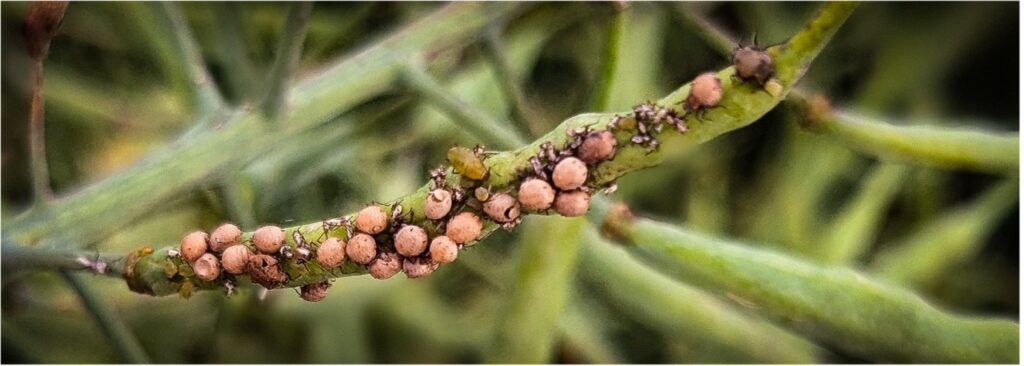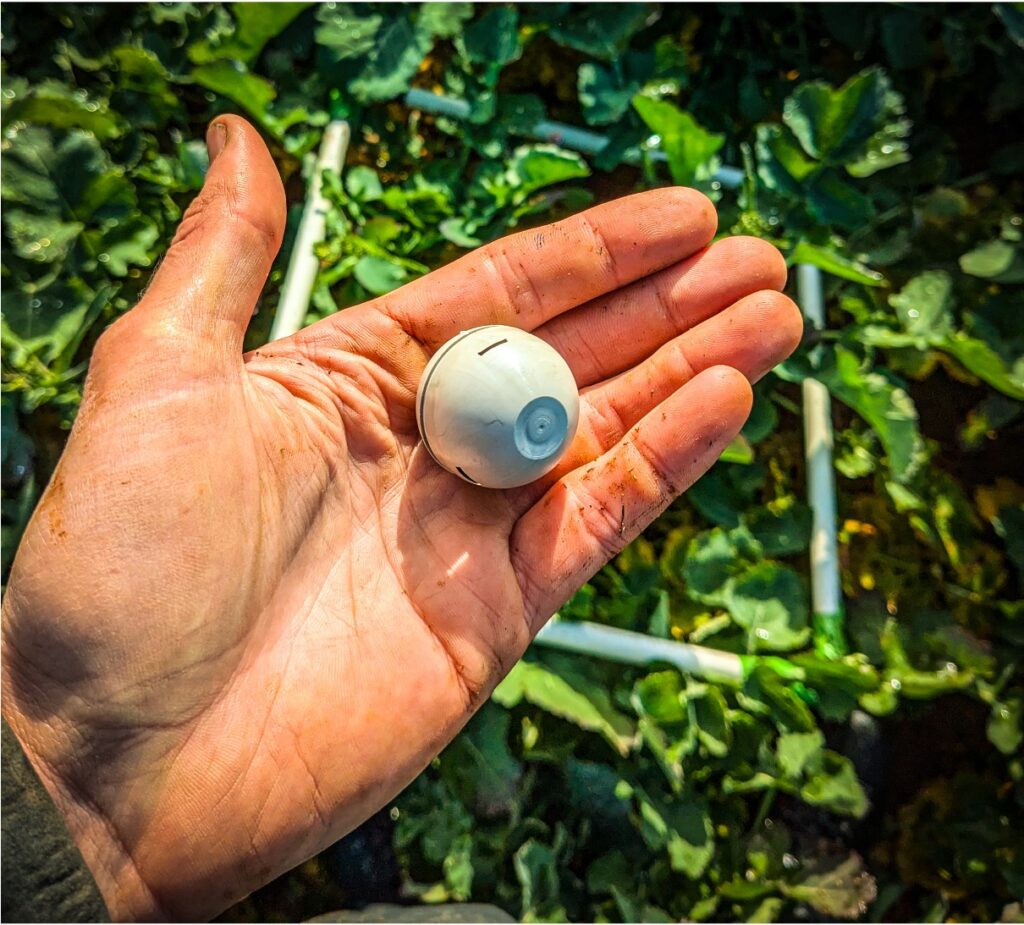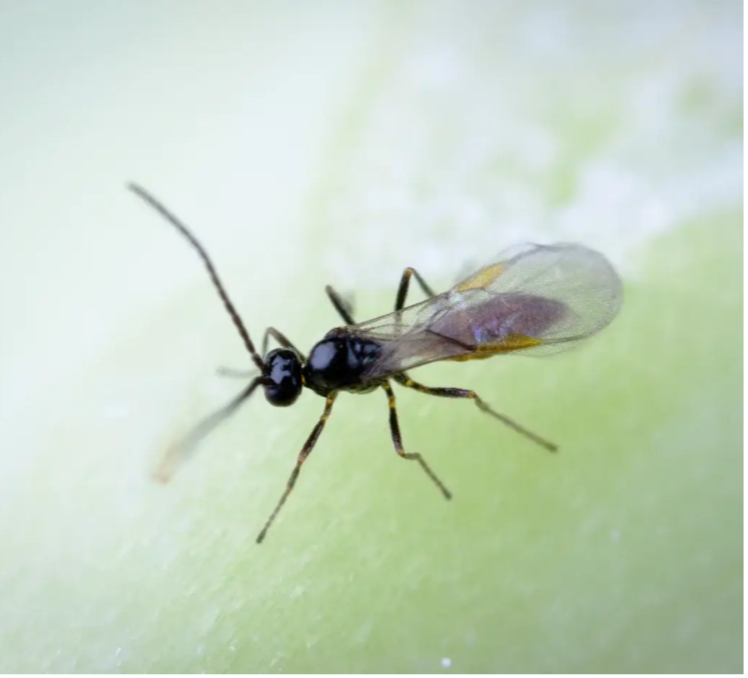Aphids are one of the biggest headaches for canola growers. They spread diseases, reduce yield, and evolving insecticide resistance makes their management difficult. But what if nature could do some of the heavy lifting?
New research shows that releasing beneficials insects, specifically parasitoid wasps, into canola crops could help keep aphid numbers down. But it’s not as simple as just releasing wasps and walking away.
Here’s what the latest findings reveal about the potential (and the limits) of using beneficial insects in canola.
Small Allies in Big Crops: Biocontrol in Canola
Tiny parasitoid wasps—like Diaeretiella rapae, Aphidius colemani, and Aphidius ervi—can help suppress aphids in canola crops. A female wasp will lay her eggs inside aphids, and as the larvae develop, they eat the pest from the inside out, effectively helping to control the population numbers.

These species are naturally present in most crops, but their impact can be boosted by augmentative biocontrol, where commercially reared wasps are strategically released to reinforce natural populations and help control pests. Augmentative biocontrol reduces the time gap between pest population outbreaks and the response of natural enemies, allowing for better pest control.
To date, augmentative biocontrol has shown the most success in high-value and protected area cropping environments.
But, for broadacre crops, does augmentative biocontrol actually work as well in practice as it does in theory? The answer isn’t so simple, and many growers are still left wondering about the real-world effectiveness of this approach compared to conventional control.
New Research, Real-World Answers
New research led by Cesar Australia, in collaboration with the University of Melbourne, the Crop Capsules Company, Biological Services, and Bugs for Bugs, as part of a project funded by the GRDC, is stepping up to answer these questions and provide the real-world data growers need.
To explore this, the project is asking four questions:
- Parasitoids vs chemicals: How well do augmented and natural parasitoids suppress aphids when compared to chemical control?
- Do the wasps stick around?: Can released wasps survive and stay active in crops over time?
- Is it worth the cost?: Of course, the economics matter. How does the cost of releasing wasps compare to chemical control?
- Do other good bugs benefit? And finally, what about the rest of the beneficial bugs—like pollinators? Does using biocontrol instead of chemicals create a friendlier environment for these species too?
Trial Design: Three Approaches to Aphid Control
The research trialled three pest management approaches across 43 experimental plots (each 5 ha) in canola paddocks spanning from Northern NSW to Southwest Victoria:
- Conventional chemical control – Standard insecticide used whenever needed.
- Natural parasitoids – No insecticides; parasitoids established naturally.
- Augmented parasitoids – A mix of three commercially produced parasitoid species (D. rapae, A. colemani, A. ervi) released at 1,000 wasps per hectare using biodegradable capsules from crop capsules.

Each plot was surveyed in winter (pre-release) and spring (peak aphid and parasitoid activity). Researchers recorded aphid numbers, parasitism rates, crop conditions, and collected aphid mummies to identify emerging parasitoids.
So, how exactly does this approach stack up against pesticides in broadacre cropping?
Real-world results: the early implications of parasitoids wasps in canola
1. Releasing wasps can significantly reduce aphid numbers—especially in the right conditions
In Victoria and Southern NSW, releasing parasitoid wasps made a noticeable difference, with aphid numbers 40-50% lower compared to paddocks without augmentation. That’s a big win!
However, in Northern and Central NSW, augmentation did not affect aphid densities, highlighting that other factors, like climate and low aphid abundance, can influence success. The project will explore these seasonal differences more in 2025!

The takeaway: Region and seasonal conditions are favourable, and augmentation could be a valuable addition to your pest management strategy.
2. Releasing wasps can slow aphid outbreaks
In general, aphid numbers were consistent from the first to second visit. If there were a lot of aphids at the start of the season, there were usually still a lot later on in spring.
But in the plots where wasps were released, it appeared to slow aphid population growth between winter and spring. Essentially, the parasitoid release helped reduce the potential for large aphid outbreaks later in the season.

3. Broad-spectrum insecticides can wipe your beneficials.
Unfortnately, conventional insecticides could be wiping out the very wasps that help keep aphids in check.
In paddocks without spraying, there was a clear pattern: when aphid numbers rose, so did parasitoid activity, with more aphids being mummified. But in sprayed paddocks, that link disappeared. This wasn’t surprising, given most insecticides registered in Australian grains are toxic to parasitoids.

Takeaway: If you want to integrate biocontrol, you need to think carefully about when and how you use insecticides. Before reaching for the spray, check the Beneficials Chemical Toxicity Table to assess potential risks to parasitoids in your crop.
4. One wasp stood out as the best candidate
Of the 3,500 wasps collected and reared in this study, 97% were D. rapae. Other species, like A. ervi and A. colemani, barely established despite augmentation efforts.

Why does this matter? If you’re investing in biocontrol, you want to back the species that actually works.
But here’s the challenge: canola isn’t grown in the same paddocks year after year. It’s typically rotated with other crops, like wheat. How parasitoid populations persist across crop rotations, not just in canola, will be an important focus for future research
5. Frost Can Undermine Augmentation Efforts
Cold snaps can be tough on parasitoids. Parasitoid releases were effective when frost was minimal, but when frost occurred twice or more within two weeks after release, the wasps’ ability to control aphids took a hit and aphid numbers were just as high, or even higher, than in untreated paddocks.
Takeaway: Timing is important! Releasing wasps when conditions are right gives them the best shot at controlling aphids effectively.
Next steps!
The project will continue to investigate the effectiveness of parasitoid biocontrol in 2025 and 2026. It will test whether the encouraging results of 2024 can be repeated (or improved!) in these years, considering that environmental conditions affecting aphid and parasitoid abundances can vary significantly from year to year.
The Bottom Line: An Opportunity Worth Exploring
Aphids are an expensive problem, and with insecticide resistance on the rise, growers need more tools in their pest management toolkit.
While there isn’t yet technology available for widescale adoption of parasitoid augmentation in canola, the research shows that it has significant potential. By understanding the factors that influence its success—like timing, regional conditions, and parasitoid species—we can fine-tune our approach for better results. If we can nail down these factors, parasitoid augmentation could become a reliable tool in your pest management toolbox.
If you’d like to learn more, register for our upcoming webinar on April 30th!
Acknowledgments
Assessing the ecological and economic benefits of controlling aphid pests of canola with parasitoid wasps (CES2307-001RTX) is delivered by Cesar Australia in collaboration with The University of Melbourne, The Crop Capsules Company, Biological Services, and Bugs for Bugs. The project is very grateful to the growers and agronomists participating in the project, who have kindly provided us with the resources to run these trials on their property and contributed their time to supporting the project. The project aims to use field-based investigations to assess the biological, ecological, and economic benefits provided by natural enemies, with a focus on ensuring that all findings are translated into practical, achievable, and profitable management recommendations and resources for growers and advisors. This initiative is a GRDC investment and includes in-kind contributions from all project partner organizations.
Thanks to Evatt Chirgwin for technical revisions.
Cover image: Photo by Andrew Weeks, Cesar Australia
